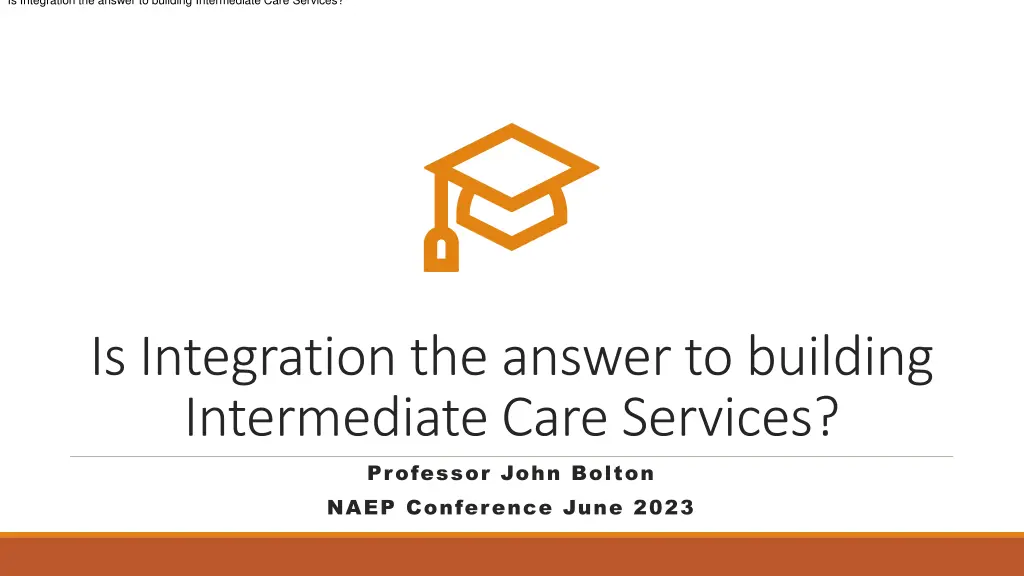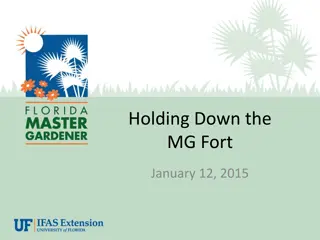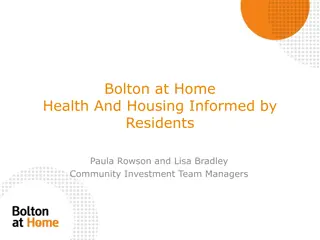
Integrating Intermediate Care Services for Older Adults
Explore the significance of integrating intermediate care services for older adults to support their discharge from hospitals, facilitate recovery, and create tailored care pathways. Learn about the challenges, progress, and strategies involved in improving post-acute care for older individuals.
Download Presentation

Please find below an Image/Link to download the presentation.
The content on the website is provided AS IS for your information and personal use only. It may not be sold, licensed, or shared on other websites without obtaining consent from the author. If you encounter any issues during the download, it is possible that the publisher has removed the file from their server.
You are allowed to download the files provided on this website for personal or commercial use, subject to the condition that they are used lawfully. All files are the property of their respective owners.
The content on the website is provided AS IS for your information and personal use only. It may not be sold, licensed, or shared on other websites without obtaining consent from the author.
E N D
Presentation Transcript
Is Integration the answer to building Intermediate Care Services?" Is Integration the answer to building Intermediate Care Services? Professor John Bolton NAEP Conference June 2023
There has been much progress in understanding what is required to support the discharge of older people from hospital: * A good percentage of older people leaving an acute hospital will require a period of recovery/recuperation/rehabilitation to help them get back on their feet Update on Discharging Older People from Hospital * The recognition that different older people will require different care pathways 1-4 in Wales; 0-3 in England! * The recognition that older people should not be assessed in a hospital bed for their longer- term care it will be significantly incorrect Discharge to Recover then assess This requires the creation of a local set of Intermediate Care Services supporting discharge (step down) and supporting admission avoidance (Step-Up).
Most older people will require a period of recovery/recuperation post-acute episode More bed days are lost to the system from the processes within an acute hospital than from people with no criteria to reside processes in hospital can be bureaucratic and cumbersome including waiting for transport / waiting for assessment / waiting for drugs / waiting for .etc The length of stay of a patient determines the amount of help and support they will require the longer the stay the more the amount of deconditioning makes a big impact Use of catheters can put back people s recovery time and keep older people bed bound How quickly are patients encouraged to mobilise after surgery/ medical treatment? Risk Averse practices can have a negative impact on an older person the staff desire to help someone can have the opposite impact a little bit of care may be bad for someone People can go home with support from community/neighbours/volunteers to keep an eye on someone Don t assess someone in an acute bed for their long-term care needs (few exceptions)
Many places have yet to develop a concrete demand and capacity plan Number of patients being discharged from hospital in England has increased BUT the numbers ready for discharge has increased by more the capacity has not been commissioned to cope with the increasing demand (Health Foundation Why are delayed discharges increasing? Seeing the bigger picture March 2023) 60% of older people leave hospital on the wrong care pathway most are given a higher level of service than their needs indicate ensure each patient has the right level of support and focus on helping older people get home wherever possible (Newton Why not home Why not today Nov 2017) Many health and care systems lack significant capacity to meet the demand some by as much as 50% (Professor John Bolton Developing a capacity and demand model for out of hospital care Sep 2021)
The basic data for older people different for each acute hospital Percentage of older people being discharged on each pathway Number in a week Pathway 0 320Could be higher 59% Pathway 1 142Could be higher 26% Pathway 2 42Could be lower 8% Pathway 3 34Should be lower 6% Total 538 100
Develop your capacity and demand plan By reviewing where you have sufficient capacity and where you don t! By reviewing the decision making as to who goes on which care pathway Home First By looking at the services that have been commissioned and what must change to meet assessed needs By determining what needs to change local practices to reduce pressure on some services OR increasing commissioned services Can more older people return home on Pathway 0 (may be with community/voluntary sector support? Consider the longer-term outcomes for older people following discharge do people return to hospital, do they make a full/partial recovery/ what kind of long-term care do they require? For most Local Authorities what happens at the point of discharge determines the numbers of older people (and in what setting) they will be supporting for the next five years
Not enough Intermediate Care Older People on wrong care pathway Reduce the numbers of older people going to care homes on Pathways 2 & 3 at least half of these could have gone home in many systems Improve the recovery-based offer for those older people on Pathway 2 don t spot purchase residential care beds for this purpose Improve the efficiency and effectiveness of those who require Pathway 1 and increase capacity on Pathway 1 Work with voluntary sector to make an offer to help older people return home with minimum support on Pathway 0 taking pressure off Pathway 1 Improve community and bedded offer for older people with demntias
Good Intermediate Care should be jointly commissioned There should be a wide range of services in the community that will support older people at the point of discharge this ranges from community and voluntary effort to help people when they return home and to offer support and to keep an eye on them; Rapid response health services including District Nurses to help manage the health aspects of someone s condition working with local GPs and Community Health Teams Domiciliary Care reablement services that are therapy led and support the recovery of older people Specialist Dementia Care services that can use assistive technology to help those with dementias to be safe to return home Palliative care support that can help people to spend their last months at home A similar set of services (but much fewer) that offer short-term bedded support (including community hospitals) that are focused on recovery and are therapy and nursing led - not discharge to dump!
Avoid discharging people on the wrong care pathway it will lead to poorer outcomes; more readmissions and higher costs to all important to get that decision right Avoid Commission Commission the right quality of service in the right quantity to meet your local need Focus on outcomes - % of older people who have been helped who require no further formal assistance measure providers against outcomes Outcomes Key messages Allow providers of recovery-based services to reduce their service as they see fit (Trusted assessor) Trusted Assessors Long Term assessments Undertake assessments for long term care after a period of recovery (MDT) Reconnect Help people adjust back into their communities more than just physical recovery
Contact Me: Professor John Bolton john.bolton@jrfb.co.uk R E A D P A P E R S : R E A D P A P E R S : D E V E L OP I N G A C A P A C I T Y A N D D E M A N D M O D E L F O R D E V E L OP I N G A C A P A C I T Y A N D D E M A N D M O D E L F O R O U T O F H O S P I T A L C A R E O U T O F H O S P I T A L C A R E D E V E L O P I N G A C A P A C I T Y A N D D E M A N D M O D E L F O R O U T - O F - H O S P I T A L C A R E ( L O C A L . G O V . U K ) H T T P S : / / I P C . B R OO K E S . A C . U K / P U B L I C A T I O N S . H T M L H T T P S : / / I P C . B R OO K E S . A C . U K / P U B L I C A T I O N S . H T M L C O M M I S S I ON I N G O U T O F H O S P I T A L C A R E T O C O M M I S S I ON I N G O U T O F H O S P I T A L C A R E T O R E D U C E D E L A Y S R E D U C E D E L A Y S N E W D E V E L O P M E N T S I N S O C I A L C A R E N E W D E V E L O P M E N T S I N S O C I A L C A R E R E D U C I N G D E L A Y S I N H O S P I T A L T R A N S F E R S I N T H E R E D U C I N G D E L A Y S I N H O S P I T A L T R A N S F E R S I N T H E C A R E O F O L D E R P E O P L E : K E Y M E S S A G E S I N C A R E O F O L D E R P E O P L E : K E Y M E S S A G E S I N P L A N N I N G A N D C O M M I S S I ON I N G P L A N N I N G A N D C O M M I S S I ON I N G






















